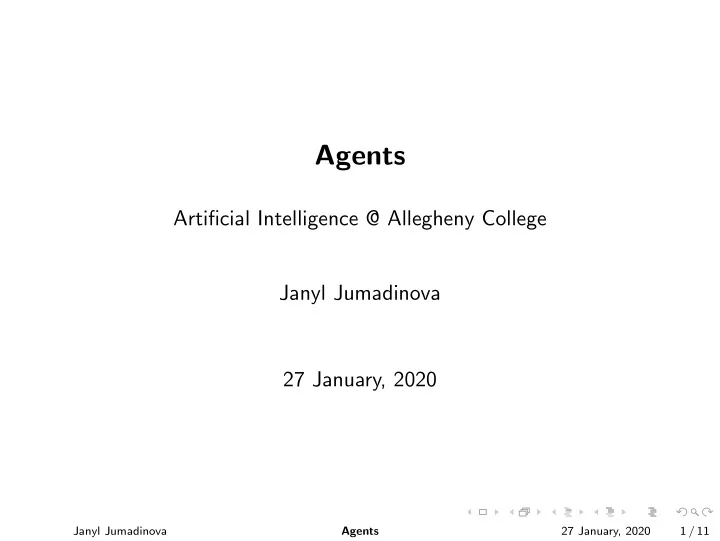

Agents Artificial Intelligence @ Allegheny College Janyl Jumadinova 27 January, 2020 Janyl Jumadinova 27 January, 2020 1 / 11 Agents
Arduino From an Arduino Website: “Arduino is an open-source prototyping platform based on easy-to-use hardware and software. Arduino boards are able to read inputs - light on a sensor, a finger on a button, or a Twitter message - and turn it into an output - activating a motor, turning on an LED, publishing something online. You can tell your board what to do by sending a set of instructions to the microcontroller on the board. ” Janyl Jumadinova 27 January, 2020 2 / 11 Agents
Arduino Janyl Jumadinova 27 January, 2020 3 / 11 Agents
Arduino Janyl Jumadinova 27 January, 2020 4 / 11 Agents
Arduino: has two rows of connectors (the ‘headers’), a power connector and a USB connector; the brain of the board is an Atmel microcontroller (has 32 KB of storage, 2 KB of RAM, and the 8-bit processor runs at 16 MHz); the pins of the processor connect to the headers, and you can connect them to virtually anything with some code to control them; the I/O pins can be used as input pins (to connect buttons or knobs, temperature or light sensors, or keyboards and mouses) or they can be used as output pins (to connect LEDs, drive motors, connect to small displays or the Internet). Janyl Jumadinova 27 January, 2020 5 / 11 Agents
How you can damage an Arduino board: drawing more than 40mA from an output pin (1 watt/volt = 1000 milliampere); drawing more than 200mA from all output pins together; supplying more than 5v (3.3v) to an input pin; supplying more than 5v to the 5v pin; supplying more than 12v to the Vin pin; drawing more than 500mA from the 5v pin (when running off an external power supply); drawing more than 50mA from the 3.3v pin; reversing the polarity of the power supply; connecting a load to the Vin pin while using USB power; static electricity. Janyl Jumadinova 27 January, 2020 6 / 11 Agents
Basic Electronics Ohm’s Law: V = I · R describes the direct relationship between the Voltage(V), Current(I) and Resistance(R) of a circuit. An Electrical Circuit must have a continuous LOOP from Power (Vcc) to Ground (GND). Janyl Jumadinova 27 January, 2020 7 / 11 Agents
Basic Electronics Ohm’s Law: V = I · R describes the direct relationship between the Voltage(V), Current(I) and Resistance(R) of a circuit. An Electrical Circuit must have a continuous LOOP from Power (Vcc) to Ground (GND). Voltage : The amount of potential energy in a circuit (in Volts) (more energy = higher voltage). Janyl Jumadinova 27 January, 2020 7 / 11 Agents
Basic Electronics Ohm’s Law: V = I · R describes the direct relationship between the Voltage(V), Current(I) and Resistance(R) of a circuit. An Electrical Circuit must have a continuous LOOP from Power (Vcc) to Ground (GND). Voltage : The amount of potential energy in a circuit (in Volts) (more energy = higher voltage). Current : The rate of charge flow in a circuit (in Amperes). Janyl Jumadinova 27 January, 2020 7 / 11 Agents
Basic Electronics Ohm’s Law: V = I · R describes the direct relationship between the Voltage(V), Current(I) and Resistance(R) of a circuit. An Electrical Circuit must have a continuous LOOP from Power (Vcc) to Ground (GND). Voltage : The amount of potential energy in a circuit (in Volts) (more energy = higher voltage). Current : The rate of charge flow in a circuit (in Amperes). Resistance : The opposition to charge flow (in Ohms). Janyl Jumadinova 27 January, 2020 7 / 11 Agents
Solderless Breadboard Janyl Jumadinova 27 January, 2020 8 / 11 Agents
Solderless Breadboard Janyl Jumadinova 27 January, 2020 9 / 11 Agents
Basic Electronics Capacitor : is an electrical component that can store electrical charge (in the form of electrons).. Janyl Jumadinova 27 January, 2020 10 / 11 Agents
Basic Electronics Capacitor : is an electrical component that can store electrical charge (in the form of electrons).. Transistor : is a semiconductor device, that is used to switch or amplify a signal. Janyl Jumadinova 27 January, 2020 10 / 11 Agents
Basic Electronics Capacitor : is an electrical component that can store electrical charge (in the form of electrons).. Transistor : is a semiconductor device, that is used to switch or amplify a signal. Diode : is a semiconductor device that can only conduct electricity in one direction. Janyl Jumadinova 27 January, 2020 10 / 11 Agents
Basic Electronics Capacitor : is an electrical component that can store electrical charge (in the form of electrons).. Transistor : is a semiconductor device, that is used to switch or amplify a signal. Diode : is a semiconductor device that can only conduct electricity in one direction. LED (Light Emitting Diode): similar to a regular diode, but they emit the energy as light, instead of heat. Janyl Jumadinova 27 January, 2020 10 / 11 Agents
Arduino IDE Computer communicates with the Arduino microcontroller via a serial port through a USB-Serial adapter (Tools → Serial Port). Must ensure the proper board is selected (Tools → Board). Janyl Jumadinova 27 January, 2020 11 / 11 Agents
Arduino IDE Computer communicates with the Arduino microcontroller via a serial port through a USB-Serial adapter (Tools → Serial Port). Must ensure the proper board is selected (Tools → Board). Main programming concepts: digitalWrite() 1 analogWrite() 2 digitalRead() 3 if() statements / Boolean 4 analogRead() 5 Serial communication 6 Janyl Jumadinova 27 January, 2020 11 / 11 Agents
Recommend
More recommend